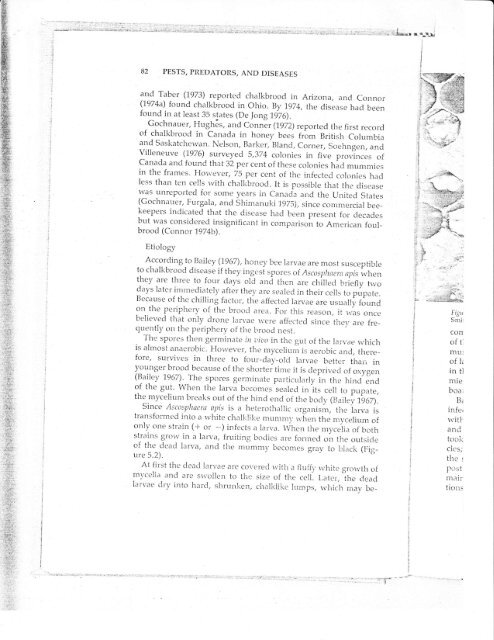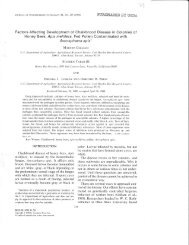Chalkbrood - Status Today and Hopes for Control' - Golden Rule Honey
Chalkbrood - Status Today and Hopes for Control' - Golden Rule Honey
Chalkbrood - Status Today and Hopes for Control' - Golden Rule Honey
You also want an ePaper? Increase the reach of your titles
YUMPU automatically turns print PDFs into web optimized ePapers that Google loves.
i:'<br />
':,<br />
82 PESTS, PREDATORS, AND DISEASES<br />
<strong>and</strong> Taber (7973) reported chalkbrood in Ariz'na, <strong>and</strong> Co.nor<br />
(1974a) found chalkbroocl in ohio. By 1974, the disease had been<br />
found in at least 35 states (De jong 1976).<br />
.Gochnauer, Hugh6s, <strong>and</strong> Conner (1972) reported the first record<br />
of chalkbrood in Ca.ada in honey bees from British Columbia<br />
<strong>and</strong> Saskatchewan. Nelson, Barker, Blancl, Corner, Soehngen, <strong>and</strong><br />
vilieneuve (1976) surveyed 5,374 coronies in five prorlinces of<br />
Canada <strong>and</strong> found that 32 per cent of these colonies hid mummies<br />
in the frames. Ilorvever, is per cent of the infected colonies had<br />
less than ten cells rvith charkbrood. Ii is possible that the disease<br />
rvas Llnreported <strong>for</strong> some years in Canacla ancl the u'ited states<br />
(Gochna'er, Furgala, ancr shimanuki1975), since cornmercial beekeepers<br />
indicated that trre discase had been prese.t <strong>for</strong> decacies<br />
but rvas considered insignificant in comparison to American foul_<br />
brood (Connor 1974b).<br />
Etiology'<br />
According to Bailey honey bee larvae<br />
!!9-67),<br />
are most susceptibie<br />
to chalkbrood disease if they i.gesi spores of Ascosprtnern aTtis i"h"r-,<br />
they are threc to four clal'5 ord anci then are crriileci briefly trvo<br />
clays latcr imrnediatell, after they are sealeci in their cells to pirpatc.<br />
Because of the chilling factor, the affectecr rarvae are usualri iJr'a<br />
on.the peripherl. of the broocl area. For this reasorr, it rr.as once<br />
believed that only drone ra^'ac *'ere affectecr since tire' are frequerrtly<br />
on the periphery of the brood nest.<br />
spores<br />
. the^ th" germin ate in t,iro in trre gui of the larvae n hich<br />
is alm'st anaerobic. Horvever, the mycelitim is aerobic <strong>and</strong>, there,<br />
<strong>for</strong>e, survi'es in three to four-day,-olcr larvae better thai, in<br />
younger brood because of the shortei time it is deFrrived of oxygen<br />
(lt"y 1967). The spores germi'ate p;rrticurarry ln the hi.d encl<br />
of the gut. When the larva becomes sealecl in its ce.ll to<br />
the mycelium<br />
f,rpate,<br />
breaks out of the hincl end of the bor1r. (Bailey t'0621.<br />
since Ascosphaera apis is a heterothalric orga'ism, the iarva is<br />
trans<strong>for</strong>med into a rvhite chalklike munlnlr,, rvilen the rtrvcelium of<br />
only o.e strain (+ or --) infects a rarva. hihen the myceiia of both<br />
strains grorv in a larva, fruiting bocries are <strong>for</strong>'retl ,r., th" outsicre<br />
of the dead larva, <strong>and</strong> tl-re r,r**1, becomes gr.a1, 1o black (Figure<br />
5.2).<br />
At first the clead larvae are covered u,ith a flulfi, rvhite gro.rvth of<br />
myceli.r <strong>and</strong> are srvollen to thc size of the ccll. Latcr, the clead<br />
larvae dry irrto harcl, shrunken, chalklike lrrinps, rvhich nav be-<br />
Figu<br />
Snri<br />
con<br />
of t.<br />
mul<br />
of li<br />
in tl<br />
mie<br />
boa'<br />
Bi<br />
infe,<br />
u'itl<br />
ancl<br />
took<br />
ck-s;<br />
tire.:<br />
post<br />
mair<br />
tion-.



